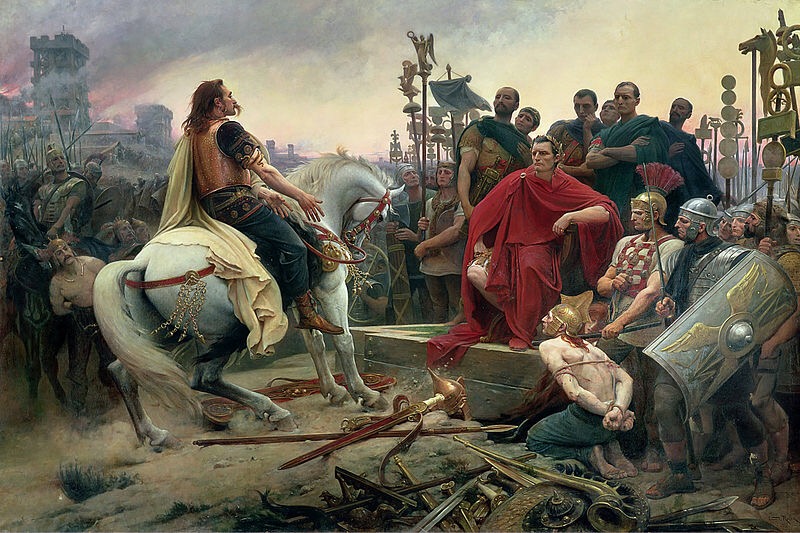
The other 5 volumes in the series have dealt with more modern warfare including such conflicts as the Vietnam War (Fire in the Lake), the War in Afghanistan (A Distant Plain) and even reaching into the 18th century and the American Revolutionary War (Liberty or Death). But Falling Sky is the series’ first foray into antiquity delving into the 1st century BC revolt against Roman control in ancient Gaul (France).
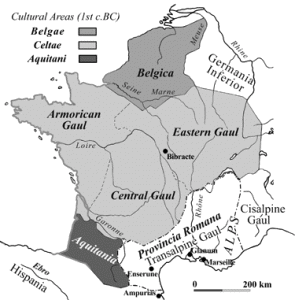
Addition of Forts & Citadels
Forts were first introduced in Liberty or Death: The American Insurrection and their main function was to reduce losses in battles where present and assist in Rally but they also added to resource collection at the end of Winter Quarters phases and contributed to victory. In Falling Sky the forts reduce losses by half in a battle by the owning side and also act as a piece to be removed. When it is down to only a fort or citadel in a battle, a 6 sided die is rolled and causes a loss of the fort/citadel only on a roll of 1-3. If the roll is a 4-6, there is no loss and that loss disappears unfulfilled. During recruit actions, the presence of a fort plus a leader and an ally allow for the placement of additional Auxilia totaling the sum of leaders+fort+allies. The forts and citadels also protect against raids from the Germanic tribes preserving resources in the Winter phase. Forts and citadels are well worth building as they offer a lot of new benefits and can make your commands more efficient. Plus they look pretty intimidating on the map!
No Traditional Support or Opposition on Spaces

A Fifth Faction – The Germanic Barbarian Tribes
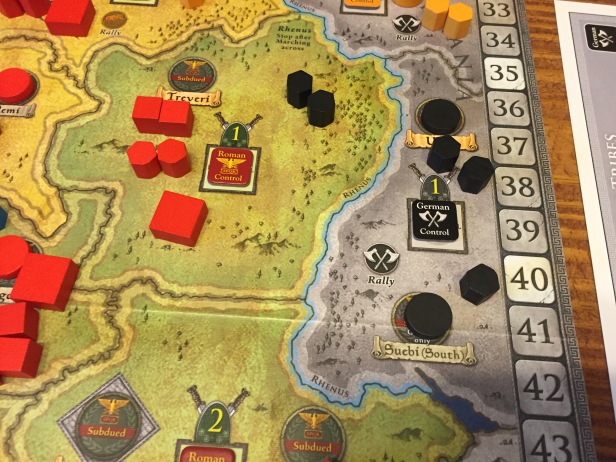
Battle Procedure – Retreat & Counterattack
The game is about battle though and how to destroy your enemies with overwhelming force. The Romans are the masters at battle as their technology, weapons and tactics were far superior to any in the ancient world. The Battle command has 6 steps but I would like to focus on only the new ones here, namely Declare Retreat, Counterattack and Retreat.
First off, the side being attacked has the option of declaring retreat once they are targeted but this action does not prevent the loss of units as you would think. If they are outnumbered and if they would rather fight in a friendly territory with a fort or citadel to limit losses in the future, retreat is a very tactical choice. What is the old saying, run away to live and fight another day! In order to retreat the retreating side must have the permission of the territory’s controlling faction that they are trying to retreat into. Without permission, there can be no retreat. The Germans never retreat or agree to allow a retreating faction into their territory. Losses are still absorbed for the retreating faction but they are unable to attack back.
The next part I’d like to focus on is Counterattack. When attack is declared and if the targeted faction doesn’t choose to retreat, their surviving forces (after taking losses from the attacker) will get an opportunity to counterattack causing losses to the attacking force. The losses from the attack will have weakened their capability to attack back but it allows at least something for the target. I also like the rules for removing Legions, Leaders or forts or citadels. If the final remaining pieces are one of the above the defender rolls a 6 sided die for each loss that is to be suffered and on a roll of 1-3 results in a loss of the units but if a 4-6 there are no losses. I like the battle procedure but it definitely takes some getting used to and at first seems a little complex as you have to follow a fairly large flow chart.
Leaders Abilities
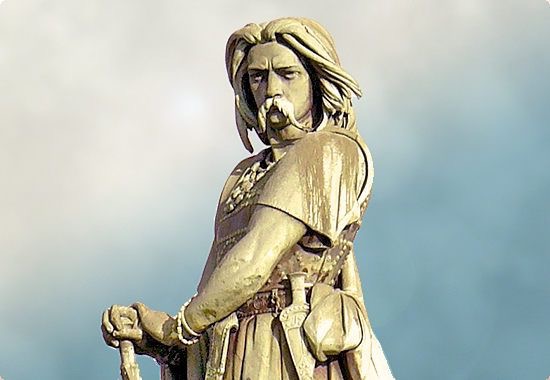

New Special Abilities – Scout, Besiege, Devastate and Rampage
There are several examples of new Special Abilities in Falling Sky for each faction including Scout (my personal favorite), Besiege, Devastate and Rampage. One of the most difficult parts of fighting insurgents and guerrilla units in the other volumes is when they are hidden. In Falling Sky the Romans have a new way to reveal the hidden warbands by using the Scout Special ability. When forces are scouted, a marker is placed on them and in order to become hidden they must first remove the marker. This is a hindrance to their efforts to ambush in battle and makes them easier to eliminate. The Romans also have the new ability of Besiege where they can assault a citadel and remove it from the board but not before it halves the losses from the battle.
For the Arverni, there is the Devastate special ability. This ability allows them to slash and burn areas to hinder and slow the March and other Roman Commands. The devastated marker blocks Recruit and Rally, doubles a region’s command cost, halts March, blocks Roman resource seizure and Raid and hinders quartering in a region over Winter. This also causes the Arverni forces to have to remove 1 in 4 of their forces as well as 1 in 3 of other faction’s forces. It is definitely a last ditch effort but when used strategically it causes serious difficulty for the invading Romans. The Belgic Tribes have the ability to Rampage. The Rampage demonstrates ferocity and is designed to frighten forces causing them to retreat or even surrender. It is foiled though if their is a leader, citadel or fortress in the region.
The new abilities are very thematic and really help the players to understand the tactics and motivations of each of the factions. From the ferocity of the Belgic tribes to the win at all cost attitude of the Arverni, the new Special Abilities of the factions help establish the identity of Falling Sky and separate it from its brother COIN games.
Capability Markers

The Capability Markers are handled in a very different and improved, I might add, way than the previous volumes. In the past, the player would have placed a small marker on the board in the capabilities area to remind them of a special addition or discount to various actions. In Falling Sky, the card event that granted the continuing capability is marked with a marker that says either “shaded” or “unshaded” by placing the card and marker in front of the player for quick and easy reference. I was able to have the full text of the capability directly in front of me in easy access so I could readily review the full text to remind me of the added ability. This eliminated me forgetting about the capability and also allowed me to think about the best ways to utilize the benefit as I planned for each turn. I think this is a big improvement over some of the previous volumes.
Board Size (Addition of Faction Available Forces Display Cards)
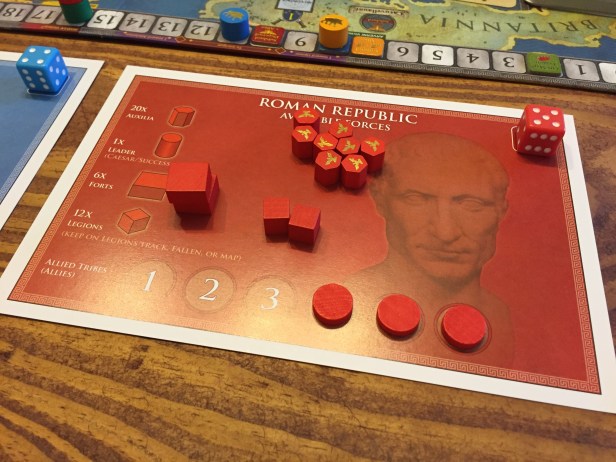
I hope that this preview has opened your eyes and educated you on some of the differences in Falling Sky: The Gallic Revolt Against Caesar and helps you in making a decision about whether to play this ancient version of the COIN series or to add it to your collection. I definitely love this game and while I have only played the walk through and one 2-player game, I can definitely see that the hype around the game is real and justified. I look forward to many plays of this game in the near future and the hours of enjoyment that are ahead.
-Grant
